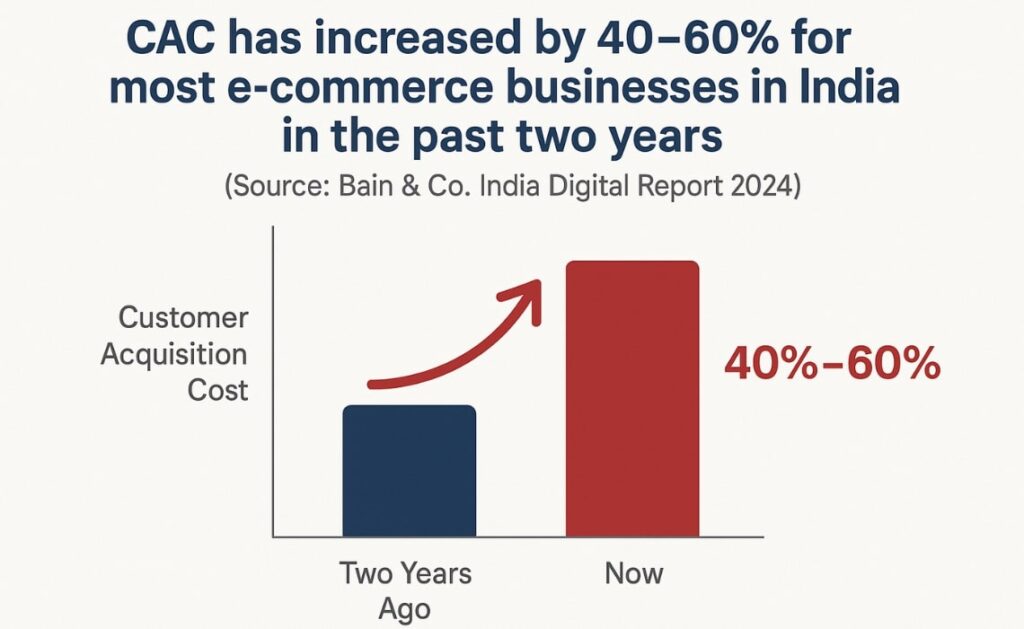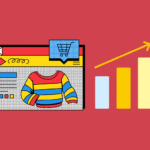Table Of Content
- Why CAC is Rising in Indian E-commerce
- 1. Ad Platforms Have Become Costlier
- 2. Short Video Craze = Higher Costs, Lower Attention
- 3. Consumer Fatigue
- Why Content Marketing Works in India
- What Indian Brands Get Wrong About Content Marketing
- My Playbook for E-commerce Content Marketing in India
- 1. Build Hyper-Local Content Hubs
- 2. Win on Video—but Keep it Regional
- 3. Own Informational Keywords
- 4. Integrate WhatsApp Content Marketing
- 5. Build Regional Trust with Storytelling
- 6. Optimize for Voice Search
- 7. Go Beyond Blogs—Diversify Content Formats
- How to Measure Content ROI in India
- Example ROI Calculation
- Tools for E-commerce Content Marketing in India
- My 2025 Content Marketing Checklist for Indian E-commerce
- Final Word
- FAQs on Content Marketing and CAC in India
“In India, clever beats costly. And nowhere is this truer than in content marketing.”
When I look back at my last 10+ years navigating India’s e-commerce ecosystem—from corporate boardrooms to dusty startup warehouses—one thing stands out:
Customer Acquisition Costs (CAC) are killing brands.

Once, you could run some Facebook ads, throw in a discount, and customers would flood in. But not anymore.
In India, CAC has increased by 40-60% for most e-commerce businesses in the past two years (Source: Bain & Co. India Digital Report 2024). Even legacy brands are feeling the pinch. Venture-funded D2C startups who once bragged about “growth at all costs” are quietly slashing marketing budgets because every new customer is getting more expensive to acquire.
But here’s the silver lining:
“Content is the cheapest, most sustainable way to acquire and retain customers in India. IF you do it right.”
Let’s talk about how.
Why CAC is Rising in Indian E-commerce
First, let’s understand why things have changed so dramatically.
1. Ad Platforms Have Become Costlier
- Meta CPCs and CPMs have shot up by 30-50% in the last two years.
- Competition for ad slots is intense in categories like beauty, wellness, apparel, and electronics.
- Even Google search ads have seen increased bids due to aggressive new entrants.
2. Short Video Craze = Higher Costs, Lower Attention
Reels, Shorts, Moj, Josh… everyone’s fighting for 15-second attention spans.
- The cost of producing quality video content has gone up.
- Engagement is high, but conversions are often low unless your creative is perfect.
3. Consumer Fatigue
- Audiences are bombarded with ads every second.
- Trust is low.
- Regional differences make scaling a single message impossible.
“Running paid ads alone is like burning cash in a bonfire — pretty to look at, but it leaves you broke.”
Instead, sustainable growth lies in content marketing.
Why Content Marketing Works in India
Here’s why content is your secret weapon:
- Lower cost per lead than pure paid ads
- Builds trust and authority—critical in India’s skeptical market
- Works brilliantly in regional languages
- Improves SEO, helping you own valuable search terms
- Keeps working even when your ad budget pauses
And the biggest advantage?
“Good content attracts the RIGHT customer—who costs less to convert.”
What Indian Brands Get Wrong About Content Marketing
Let me be blunt:
Most brands in India are doing content marketing WRONG.
Here’s what I see all the time:
- Generic blog posts with no keyword research
- Copy-pasting Western content calendars
- No regional language strategy
- Content created purely for SEO, with zero storytelling
- Obsession with vanity metrics (likes, impressions) instead of revenue
“In India, content marketing is NOT about writing blogs. It’s about becoming the voice your customers trust.”
Let’s get into how to do it right.
My Playbook for E-commerce Content Marketing in India
These are strategies I’ve used and seen work across multiple brands:
1. Build Hyper-Local Content Hubs
India isn’t one market—it’s dozens. Your content strategy must reflect that.
Instead of writing generic posts like:
“Best sarees for weddings.”
Go local:
- “Best Sambalpuri sarees for Odia weddings in Bhubaneswar.”
- “Cotton sarees for summer festivals in Kolkata.”
- “Affordable festive wear for Onam in Kochi.”
This is why regional SEO is a game-changer (see my article E-commerce Marketing Strategies in India: What Actually Works in 2025).
- Lower competition on search terms
- Higher conversion rates
- Cheaper cost per lead
A 2024 study from SEMrush revealed that regional long-tail keywords in India have 2-3x higher conversion rates compared to generic terms.
2. Win on Video—but Keep it Regional
Video is king—but only if localized.
- Shoot reels in Hindi, Tamil, Bengali—whichever dominates your target region.
- Feature real customers using your products.
- Add subtitles for wider reach.
Case study:
A handloom brand I worked with switched from English reels to Odia-language reels. Engagement grew 4.2x, and video-led conversions jumped 28% in three months.
3. Own Informational Keywords
Most e-commerce brands only target transactional keywords (e.g., “buy organic spices online”).
But here’s the secret:
Indians search a lot before they buy.
Instead of just “buy saffron,” they search:
- “How to check purity of saffron?”
- “Benefits of Kashmiri saffron for skin.”
- “Recipes using saffron.”
These are informational keywords. Ranking for them builds trust, brand recall, and drives purchase decisions.
Content ideas:
- “How to identify real vs fake saffron in India”
- “5 ways to style a Sambalpuri saree for weddings”
- “Best natural oils for summer hair care in India”
4. Integrate WhatsApp Content Marketing
I’ve said it before: for many Indians, WhatsApp IS the internet.
- Share blog summaries via broadcast lists
- Send personalized product guides
- Run Q&A sessions in regional languages
- Deliver festival discounts via WhatsApp
Brands that combine content + WhatsApp see:
- Lower CAC
- Higher repeat purchases
- More trust
5. Build Regional Trust with Storytelling
Indian buyers want to see themselves in your story.
Don’t just write product posts. Tell real stories:
- A farmer growing turmeric in Kandhamal
- A woman weaver creating sarees in Odisha
- A customer’s transformation story using your product
Stories outperform pure product posts by 3-5x in engagement and conversion rates (Meta India Data, 2024).
6. Optimize for Voice Search
A 2024 report from Google India stated:
“More than 35% of Indian internet users now use voice search regularly.”
If your content:
- Uses natural language
- Answers questions clearly
- Includes regional terms
…you’re ahead of 90% of brands in India.
Examples:
- “Which saree is best for Durga Puja?”
- “How to check if saffron is pure?”
- “Cheapest cash-on-delivery options in India?”
7. Go Beyond Blogs—Diversify Content Formats
India’s diverse audience consumes content in different ways:
- Infographics in regional languages
- WhatsApp audio messages
- Reels and Shorts
- Interactive quizzes
- Regional podcasts
“The same message delivered via 3 formats = triple the recall.”
How to Measure Content ROI in India
I’ll be honest: measuring ROI from content is tricky—but not impossible.
“If your content doesn’t drive revenue or retention, it’s not content marketing. It’s charity.”
Here’s what I track:
- Cost per content-led lead
- Leads-to-sales ratio from blog traffic
- WhatsApp engagement rates
- Regional keyword rankings
- Repeat purchase rates among content readers
Example ROI Calculation
Let’s say you write an article:
“How to identify pure saffron in India”
- Cost to produce: ₹6,000
- Monthly traffic: 4,000 visitors
- Conversion rate: 1.2%
- Avg order value: ₹750
Revenue from this blog:
→ 4,000 x 1.2% = 48 orders → 48 x ₹750 = ₹36,000/month revenue
Your blog pays itself back in under a week.
Tools for E-commerce Content Marketing in India
Here’s my 2025 recommended stack:
- NeuronWriter or Surfer SEO – For Indian keyword insights
- Canva Pro – Regional creatives, reels, blog graphics
- Zoho CRM – Affordable and India-friendly
- WhatsApp Business API – For hyperlocal content delivery
- Hotjar or Microsoft Clarity – See how Indians navigate your pages
- Grammarly or Linguix – Essential for Hinglish or English quality
My 2025 Content Marketing Checklist for Indian E-commerce
Here’s a quick checklist to keep your strategy sharp:
- Are you targeting regional long-tail keywords?
- Do you produce content in regional languages?
- Are your blogs addressing informational searches, not just product sales?
- Are you using WhatsApp for content delivery?
- Do you have real stories, not just product specs?
- Are you repurposing content into reels, audio, and images?
- Are you tracking actual revenue from content?
- Are you testing new content formats each quarter?
Final Word
India’s digital landscape is changing fast. Paid ads will keep getting costlier. But content marketing is the only moat that grows deeper over time.
“In India, content isn’t just king—it’s the entire royal family.”
If you’re building a brand in Bharat, your mission is simple:
- Speak the language your customers speak.
- Tell stories that reflect their lives.
- Answer the questions they’re searching for.
- Build trust before you sell.
Because when you do that, CAC isn’t a cost—it’s an investment that keeps paying you back.
Keep it real. Keep it Bharat.
— Debansh Das Sharma, The Unfiltered Founder
FAQs on Content Marketing and CAC in India
Q1. How much should I spend on content marketing in India?
→ For early-stage brands, allocate 20-30% of your marketing budget toward content. For lower budgets, focus on blogs, WhatsApp, and regional SEO.
Q2. Which language should I use for content marketing?
→ Depends on your audience. Hindi dominates large parts of Bharat, but regional languages like Bengali, Tamil, or Telugu can dramatically improve trust and conversions.
Q3. Is video necessary for e-commerce content marketing?
→ Yes—especially short-form video in regional languages. It drives high engagement and trust.
Q4. Does content marketing really reduce CAC in India?
→ Yes. Brands investing in content report 20-50% lower CAC compared to those relying only on ads (Bain & Co. India, 2024).
Q5. What’s the biggest mistake Indian e-commerce brands make in content marketing?
→ Copy-pasting Western content plans without local context. Bharat is different.




